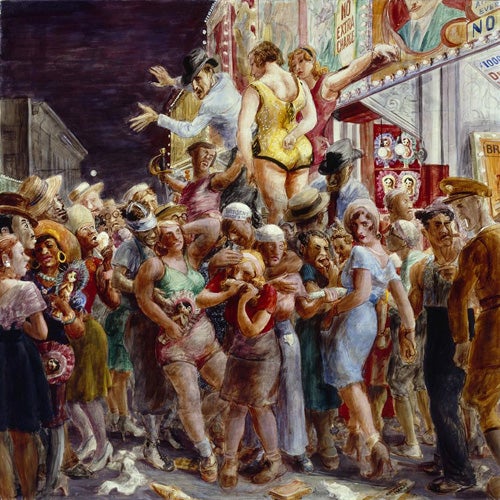
When the weather starts getting unbearable New Yorkers—Artstor staff included—flock to the boardwalks of Brooklyn’s Coney Island or Rockaway Beach in Queens.
This ritual is nothing new and was, in fact, one of the pet subjects of Reginald Marsh (1898 –1954), an American artist famous for his paintings of New York City in the ’20s and ’30s. His city scenes are remarkable for their palpable sense of movement—bodies walk or loiter on street corners, crowds swell as New York’s lights pulsate and glow in the background.
That Marsh’s canvases seem to vibrate is due not only to his staccato brush strokes and bright, reflective colors, but also to his choice of subject matter. Rather than portray New York City’s elite, Marsh turned to everyday people and entertainments. Favorite subjects included burlesque and Vaudeville performers, pedestrians and, yes, public beaches.
Marsh used the beach as a way to show average city-dwellers at play. An example is the arresting Wonderland Circus, Sideshow Coney Island from the John and Mable Ringling Museum of Art. Painted in 1930, the piece shows crowds on the Coney Island boardwalk jostling in front of the entrance to a sideshow circus. Performers beckon to the passersby. Some are amazed, while others appear too involved in their own personal dramas to notice the one unfolding next to them.
![Reginald Marsh [People at Coney Island beach.], ca. 1938, Museum of the City of New York. © 2012 Estate of Reginald Marsh / Art Students League, New York / Artists Rights Society (ARS), New York](https://about.jstor.org/wp-content/uploads/2014/05/amcnyig_10313883156s.jpg)
![Reginald Marsh, [Woman performing stunt on Coney Island beach.], ca. 1938, Museum of the City of New York. © 2012 Estate of Reginald Marsh / Art Students League, New York / Artists Rights Society (ARS), New York](https://about.jstor.org/wp-content/uploads/2014/05/amcnyig_10313884438.jpg)
As in Marsh’s paintings, movement is a recurring theme. Movement is perhaps best captured in his series of works on amusement park rides. In many, carousel horses whir by. In “Man riding the Human Pool Table at Steeplechase Park,” a personal favorite, an adult rotates on a spinning disk. (Unfortunately, this ride no longer exists.)
Marsh’s camera lens also noticed and focused on the intimate and personal moments experienced, perhaps ironically, within a crowd. In “Couple relaxing at Coney Island beach,” two sunbathers embrace, completely oblivious to the other bathers mere feet away.
Reflecting on Marsh’s beach photographs, what is most striking is that they feel so modern. The energy and spirit of 1930s New Yorkers at the beach looks pretty similar to that of beachgoers today, although the latter’s faces are more likely to be captured on iPhone screens and Instagram feeds than in analog photography.
![Reginald Marsh, [Man riding the Human Pool Table at Steeplechase Park.], ca. 1938, Museum of the City of New York. © 2012 Estate of Reginald Marsh / Art Students League, New York / Artists Rights Society (ARS), New York](https://about.jstor.org/wp-content/uploads/2014/05/amcnyig_10313883064-450x295.jpg)
![Reginald Marsh, [Crowd playing on Coney Island beach.], ca. 1938, Museum of the City of New York. © 2012 Estate of Reginald Marsh / Art Students League, New York / Artists Rights Society (ARS), New York](https://about.jstor.org/wp-content/uploads/2014/05/amcnyig_10313884203-450x291.jpg)
![Reginald Marsh, [Man carrying woman on shoulders at Coney Island beach.], ca. 1938, Museum of the City of New York. © 2012 Estate of Reginald Marsh / Art Students League, New York / Artists Rights Society (ARS), New York](https://about.jstor.org/wp-content/uploads/2014/05/amcnyig_10313884975-290x450.jpg)



